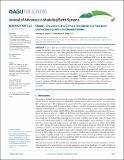| dc.contributor.author | Cronin, Timothy Wallace | |
| dc.contributor.author | Wing, Allison A. | |
| dc.date.accessioned | 2018-09-21T15:36:21Z | |
| dc.date.available | 2018-09-21T15:36:21Z | |
| dc.date.issued | 2017-12 | |
| dc.date.submitted | 2017-06 | |
| dc.identifier.issn | 1942-2466 | |
| dc.identifier.uri | http://hdl.handle.net/1721.1/118160 | |
| dc.description.abstract | Tropical cloud and circulation changes are large sources of uncertainty in future climate change. This problem owes partly to the scale separation between large-scale tropical dynamics (~104km) and convective dynamics (~7 km), which generally requires parameterizing convection in models that resolve large-scale dynamics, or parameterizing (or omitting) large-scale dynamics in models that permit convection. Here we discuss simulations of radiative-convective equilibrium (RCE) across a wide range of surface temperatures in long-channel geometry—where the domain size and resolution marginally resolve both large-scale dynamics and convection. Self-aggregation of convection in these simulations spontaneously produces realistic dynamical regimes of large-scale vertical motion. The circulation weakens with surface warming but changes in the degree of self-aggregation depend on the metric that is used; there is no obvious trend in aggregation with warming. Surface warming causes an upward shift and decrease in area of high clouds, and a sharp decline in midlevel clouds, but no systematic trend in low cloud cover. We introduce a method for approximate radiative kernel feedback analysis in RCE, and apply it to both simulations in long-channel geometry and in a smaller square domain. The kernel-corrected cloud feedback is positive but its magnitude varies across temperatures. Compared to simulations that do not have aggregation, there is a more negative net feedback due to the effects of aggregation on relative humidity and cloud cover. These results are consistent with the hypothesis that self-aggregation moderately reduces climate sensitivity. | en_US |
| dc.description.sponsorship | National Science Foundation (U.S.) (Grant AGS-1623218) | en_US |
| dc.description.sponsorship | National Science Foundation (U.S.) (Grant AGS-1433251) | en_US |
| dc.publisher | American Geophysical Union (AGU) | en_US |
| dc.relation.isversionof | http://dx.doi.org/10.1002/2017MS001111 | en_US |
| dc.rights | Creative Commons Attribution-NonCommercial-NoDerivs License | en_US |
| dc.rights.uri | http://creativecommons.org/licenses/by-nc-nd/4.0/ | en_US |
| dc.source | Wiley | en_US |
| dc.title | Clouds, Circulation, and Climate Sensitivity in a Radiative-Convective Equilibrium Channel Model | en_US |
| dc.type | Article | en_US |
| dc.identifier.citation | Cronin, Timothy W., and Allison A. Wing. “Clouds, Circulation, and Climate Sensitivity in a Radiative-Convective Equilibrium Channel Model.” Journal of Advances in Modeling Earth Systems 9, 8 (December 2017): 2883–2905 © 2017 The Authors | en_US |
| dc.contributor.department | Massachusetts Institute of Technology. Department of Earth, Atmospheric, and Planetary Sciences | en_US |
| dc.contributor.mitauthor | Cronin, Timothy Wallace | |
| dc.contributor.mitauthor | Wing, Allison A. | |
| dc.relation.journal | Journal of Advances in Modeling Earth Systems | en_US |
| dc.eprint.version | Final published version | en_US |
| dc.type.uri | http://purl.org/eprint/type/JournalArticle | en_US |
| eprint.status | http://purl.org/eprint/status/PeerReviewed | en_US |
| dc.date.updated | 2018-09-20T17:56:53Z | |
| dspace.orderedauthors | Cronin, Timothy W.; Wing, Allison A. | en_US |
| dspace.embargo.terms | N | en_US |
| dc.identifier.orcid | https://orcid.org/0000-0002-7807-2878 | |
| dc.identifier.orcid | https://orcid.org/0000-0003-2194-8709 | |
| mit.license | PUBLISHER_CC | en_US |
